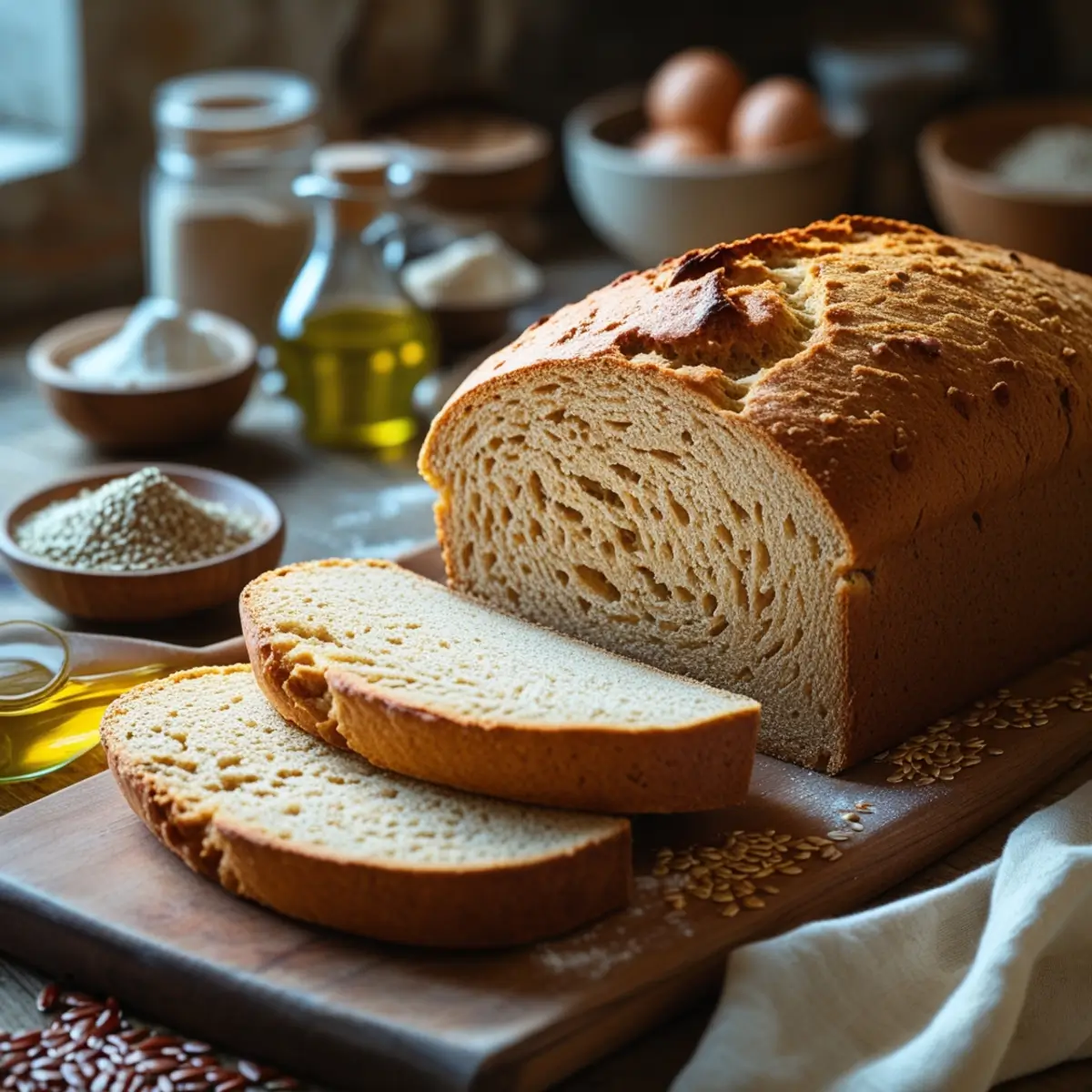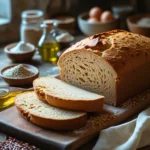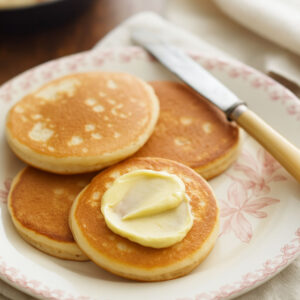Baking bread without gluten and eggs might seem challenging, but with the right approach, it’s entirely possible to enjoy soft, delicious, and wholesome bread that fits your dietary needs. Whether you suffer from gluten intolerance, egg allergies, or simply prefer a vegan lifestyle, mastering a gluten-free egg-free bread recipe opens up a world of fresh, homemade bread options free from common allergens.
In this comprehensive guide, we’ll explore everything you need to know about making perfect gluten-free, egg-free bread—from essential ingredients and baking tips to storage advice and brand recommendations. Plus, you’ll find a detailed recipe with preparation instructions, nutrition facts, and FAQs to help you bake with confidence. Let’s dive in and discover how to bake bread that’s both safe and scrumptious!

Table of contents
Table of Contents
Why Choose a Gluten-Free Egg-Free Bread Recipe?
Gluten and eggs are staples in traditional bread baking. Gluten provides the elasticity and structure that give bread its chewy texture, while eggs act as binders and moisture enhancers. However, for millions worldwide, these ingredients pose health risks:
- Gluten intolerance and celiac disease require strict avoidance of gluten to prevent digestive distress and long-term damage.
- Egg allergies, especially common in children, necessitate eliminating eggs to avoid allergic reactions.
- Many individuals adopt vegan diets, excluding all animal products including eggs.
Making your own gluten-free egg-free bread ensures you control every ingredient, avoiding hidden allergens and additives. Homemade bread also offers superior freshness and the ability to tailor flavors and textures to your preference.
Essential Ingredients for Gluten-Free Egg-Free Bread
Creating a successful gluten-free egg-free bread recipe relies on carefully selected ingredients that mimic the role of gluten and eggs.
Gluten-Free Flour Blends
No single gluten-free flour replicates wheat flour perfectly, so combining multiple flours is key:
- Rice Flour: Light and neutral, forms a good base.
- Sorghum Flour: Adds softness and a wheat-like texture.
- Tapioca Starch: Improves elasticity and chewiness.
- Potato Starch: Enhances moisture retention and structure.
- Almond Flour: Adds moisture and a subtle nutty flavor.
A blend of at least three of these flours yields the best texture.
Egg Substitutes for Binding and Moisture
Eggs provide binding and moisture; here are effective replacements:
- Flaxseed Meal (Flax Egg): Mix 1 tablespoon ground flaxseed with 3 tablespoons water; let sit until gel-like.
- Chia Seeds: Similar to flaxseed, forms a gel when mixed with water.
- Aquafaba: The liquid from canned chickpeas whipped to a fluffy consistency.
- Applesauce: Adds moisture and slight sweetness, ideal for softer breads.
Binders for Structure
Binders replace gluten’s elasticity to hold the bread together:
- Xanthan Gum: Provides elasticity and structure.
- Psyllium Husk Powder: Excellent for moisture retention and chewy texture.
Leavening Agents
To help the bread rise and become airy:
- Yeast: Active dry or instant yeast adds rise and flavor.
- Baking Powder: Supports additional lift and lightness.
Moisture and Flavor Enhancers
- Olive Oil: Keeps bread moist and adds richness.
- Honey or Sugar: Feeds yeast and balances flavor.
- Salt: Enhances overall taste.
Tips for Perfect Gluten-Free Egg-Free Bread
- Use binders like xanthan gum or psyllium husk to prevent crumbling.
- Activate yeast properly with warm water (105°F–110°F) to ensure good rise.
- Avoid overmixing; gluten-free dough is sticky and should not be too firm.
- Allow sufficient rising time (1–2 hours) in a warm, draft-free spot.
- Cool bread completely before slicing to avoid gummy texture.
Personal Story: Baking Bread for My Daughter’s Allergies
When my daughter was diagnosed with both celiac disease and an egg allergy, I was overwhelmed by how limited her bread options were. Store-bought gluten-free breads often contained eggs, and many were dry or crumbly. Determined to give her fresh, homemade bread, I experimented with different flour blends and egg substitutes until I perfected a recipe that was soft, flavorful, and safe for her to eat. Baking this bread became a family ritual, and seeing her enjoy sandwiches and toast without worry was incredibly rewarding. This experience inspired me to share this easy and reliable gluten-free egg-free bread recipe with others facing similar challenges.
Storing and Freezing Gluten-Free Egg-Free Bread
To keep your bread fresh:
- Store at room temperature in an airtight container for up to 2 days.
- Avoid refrigeration, which dries out gluten-free bread.
- Freeze sliced bread wrapped individually in plastic wrap inside a freezer bag for up to 3 months.
- Thaw at room temperature or warm in the oven for best taste.
Popular Gluten-Free Egg-Free Bread Brands
For convenience, several brands offer quality gluten-free breads without eggs:
| Brand | Egg-Free Options | Highlights |
|---|---|---|
| Canyon Bakehouse | 7-Grain Bread, Country White | Soft texture, non-GMO ingredients |
| Schär | Artisan Baker Multigrain Bread | Soft, flavorful, allergy-friendly |
| Little Northern Bakehouse | Seeds & Grains, Millet & Chia | Plant-based, free from dairy, nuts, soy |
| Food for Life (Ezekiel) | Brown Rice Bread, Sprouted Grain | Dense, nutritious, great toasted |
Always check labels to confirm egg-free status.
Gluten-Free Egg-Free Bread Recipe
Print
How to Make the Best Gluten-Free Egg-Free Bread Recipe
- Total Time: 2 hours 25 minutes
- Yield: 1 loaf 1x
- Diet: Gluten Free
Description
A soft, flavorful gluten-free and egg-free bread made with a blend of allergy-friendly flours and natural binders. Perfect for those with dietary restrictions or vegan lifestyles.
Ingredients
- 1 ½ cups gluten-free all-purpose flour blend (rice flour, tapioca starch, potato starch)
- ½ cup sorghum flour
- 2 tablespoons ground flaxseed (for flax egg)
- 6 tablespoons warm water (for flax egg)
- 1 tablespoon psyllium husk powder
- 2 teaspoons xanthan gum
- 1 tablespoon sugar or honey
- 1 ½ teaspoons active dry yeast
- 1 teaspoon salt
- 1 cup warm water (105°F–110°F)
- 3 tablespoons olive oil
- Optional: 1 teaspoon apple cider vinegar (helps with rise and flavor)
Instructions
- Prepare the flax egg: In a small bowl, combine ground flaxseed and 6 tablespoons warm water. Stir and let sit for 5-10 minutes until gel-like.
- Activate the yeast: In a separate bowl, mix warm water and sugar. Sprinkle yeast over the top and let it sit for 5-10 minutes until foamy.
- Mix dry ingredients: In a large bowl, whisk together gluten-free flour blend, sorghum flour, psyllium husk powder, xanthan gum, and salt.
- Combine wet ingredients: Add the flax egg, olive oil, and apple cider vinegar to the foamy yeast mixture.
- Form the dough: Pour wet ingredients into the dry ingredients and mix thoroughly with a wooden spoon or stand mixer fitted with a paddle attachment. The dough will be sticky and thick.
- First rise: Cover the bowl with a clean towel and place in a warm, draft-free area. Let the dough rise for 1 to 1.5 hours until it has roughly doubled in size.
- Prepare the pan: Grease a 9×5-inch loaf pan with olive oil or line with parchment paper.
- Transfer dough: Spoon the dough into the prepared loaf pan and smooth the top with a wet spatula.
- Second rise: Cover loosely and let the dough rise for another 30 minutes.
- Bake: Preheat the oven to 375°F (190°C). Bake the bread for 35-40 minutes until golden brown and a toothpick inserted in the center comes out clean.
- Cool: Remove the bread from the oven and let cool in the pan for 10 minutes. Then transfer to a wire rack to cool completely before slicing.
Notes
Here are some helpful notes about the gluten-free egg-free bread recipe, inspired and informed by various expert sources and tested recipes:
- Texture and Tenderness: Gluten-free egg-free bread can be soft and tender, perfect for toasting or making sandwiches. Using psyllium husk powder and xanthan gum helps mimic gluten’s elasticity and improves crumb softness.
- Rising and Baking Tips: Proper yeast activation with warm water (around 105°F–110°F) is crucial for a good rise. Allowing sufficient rising time (1 to 1.5 hours) in a warm, draft-free spot helps develop volume. Baking at 375°F for about 35-40 minutes usually yields a golden crust and fully cooked loaf.
- Binders and Egg Substitutes: Flax eggs, chia eggs, and aquafaba are excellent plant-based binders that provide moisture and structure without eggs. Psyllium husk powder is especially effective for moisture retention and chewiness.
- Flour Blends: Combining rice flour, sorghum flour, and starches like tapioca or potato starch creates a balanced texture. Some recipes also incorporate chickpea or buckwheat flour for added nutrition and flavor.
- Add-Ins and Variations: Adding seeds (pumpkin, sunflower, sesame) or nuts can enhance texture and flavor. Apple cider vinegar can improve rise and add subtle tang.
- Cooling and Slicing: Letting the bread cool completely before slicing is important to avoid gummy or squished slices, a common issue with gluten-free breads.
- Storage: Store bread at room temperature in an airtight container for up to 2 days or freeze sliced portions for longer storage (up to 3 months).
- Equipment: A stand mixer with a paddle attachment can simplify mixing sticky gluten-free doughs, but hand mixing works too.
- Dietary Notes: This bread is suitable for vegans and those with egg and gluten allergies. It can be made dairy-free by using plant-based oils and milk substitutes if desired.
These notes should help you understand the recipe’s characteristics and how to achieve the best results when baking gluten-free egg-free bread.
- Prep Time: 15 minutes
- Rising Time: 1 hour 30 minutes
- Cook Time: 40 minutes
- Category: Gluten-Free
- Method: Baking
- Cuisine: American
Nutrition
- Serving Size: 1
- Calories: 110 kcal
- Sugar: 2g
- Sodium: 180mg
- Fat: 3.5g
- Carbohydrates: 22g
- Fiber: 3g
- Protein: 3g
Keywords: Gluten-Free Egg-Free Bread Recipe
Category
Allergy-Friendly Bread, Vegan, Gluten-Free
Cuisine
American / Allergy-Friendly Baking
Preparation Time
- Prep: 15 minutes
- Rising: 1.5 hours
- Baking: 40 minutes
- Total: Approximately 2 hours 25 minutes
Recipe Yield
Makes 1 loaf (about 12 slices)
Ingredients
- 1 ½ cups gluten-free all-purpose flour blend (rice flour, tapioca starch, potato starch)
- ½ cup sorghum flour
- 2 tablespoons ground flaxseed (for flax egg)
- 6 tablespoons warm water (for flax egg)
- 1 tablespoon psyllium husk powder
- 2 teaspoons xanthan gum
- 1 tablespoon sugar or honey
- 1 ½ teaspoons active dry yeast
- 1 teaspoon salt
- 1 cup warm water (105°F–110°F)
- 3 tablespoons olive oil
- Optional: 1 teaspoon apple cider vinegar (helps with rise and flavor)
Instructions
- Prepare the flax egg: In a small bowl, combine ground flaxseed and 6 tablespoons warm water. Stir and let sit for 5-10 minutes until gel-like.
- Activate the yeast: In a separate bowl, mix warm water and sugar. Sprinkle yeast over the top and let it sit for 5-10 minutes until foamy.
- Mix dry ingredients: In a large bowl, whisk together gluten-free flour blend, sorghum flour, psyllium husk powder, xanthan gum, and salt.
- Combine wet ingredients: Add the flax egg, olive oil, and apple cider vinegar to the foamy yeast mixture.
- Form the dough: Pour wet ingredients into the dry ingredients and mix thoroughly with a wooden spoon or stand mixer fitted with a paddle attachment. The dough will be sticky and thick.
- First rise: Cover the bowl with a clean towel and place in a warm, draft-free area. Let the dough rise for 1 to 1.5 hours until it has roughly doubled in size.
- Prepare the pan: Grease a 9×5-inch loaf pan with olive oil or line with parchment paper.
- Transfer dough: Spoon the dough into the prepared loaf pan and smooth the top with a wet spatula.
- Second rise: Cover loosely and let the dough rise for another 30 minutes.
- Bake: Preheat the oven to 375°F (190°C). Bake the bread for 35-40 minutes until golden brown and a toothpick inserted in the center comes out clean.
- Cool: Remove the bread from the oven and let cool in the pan for 10 minutes. Then transfer to a wire rack to cool completely before slicing.
Nutritional Values (per slice, approx. 12 slices)
- Calories: 110
- Carbohydrates: 22g
- Protein: 3g
- Fat: 3.5g
- Fiber: 3g
- Sugar: 2g
- Sodium: 180mg
Frequently Asked Questions (FAQs)
What can I use instead of eggs in gluten-free bread?
Flax eggs, chia eggs, aquafaba, and applesauce are excellent egg substitutes that provide binding and moisture in gluten-free bread.
Is all gluten-free bread egg-free?
No, many gluten-free breads contain eggs, so always check ingredient labels or choose brands specifically labeled egg-free.
How do I get gluten-free bread to rise properly?
Use active yeast with warm water, allow the dough to rise in a warm place for 1–2 hours, and include binders like xanthan gum or psyllium husk to improve structure.
Can I freeze gluten-free egg-free bread?
Yes, slice before freezing, wrap slices individually, and store in a freezer bag for up to 3 months.
What’s the best flour blend for gluten-free egg-free bread?
A mix of rice flour, sorghum flour, and tapioca starch is ideal for texture and flavor.
Conclusion
Mastering a gluten-free egg-free bread recipe empowers you to enjoy fresh, homemade bread tailored to your dietary needs. By using the right flour blends, egg substitutes, binders, and leavening agents, you can create bread that is soft, flavorful, and allergy-friendly. Whether baking for health reasons or lifestyle choices, this bread offers a wholesome alternative to store-bought options, with the added satisfaction of doing it yourself.
Embrace the joy of baking with this reliable gluten-free egg-free bread recipe and bring fresh, nourishing bread to your table every day.


